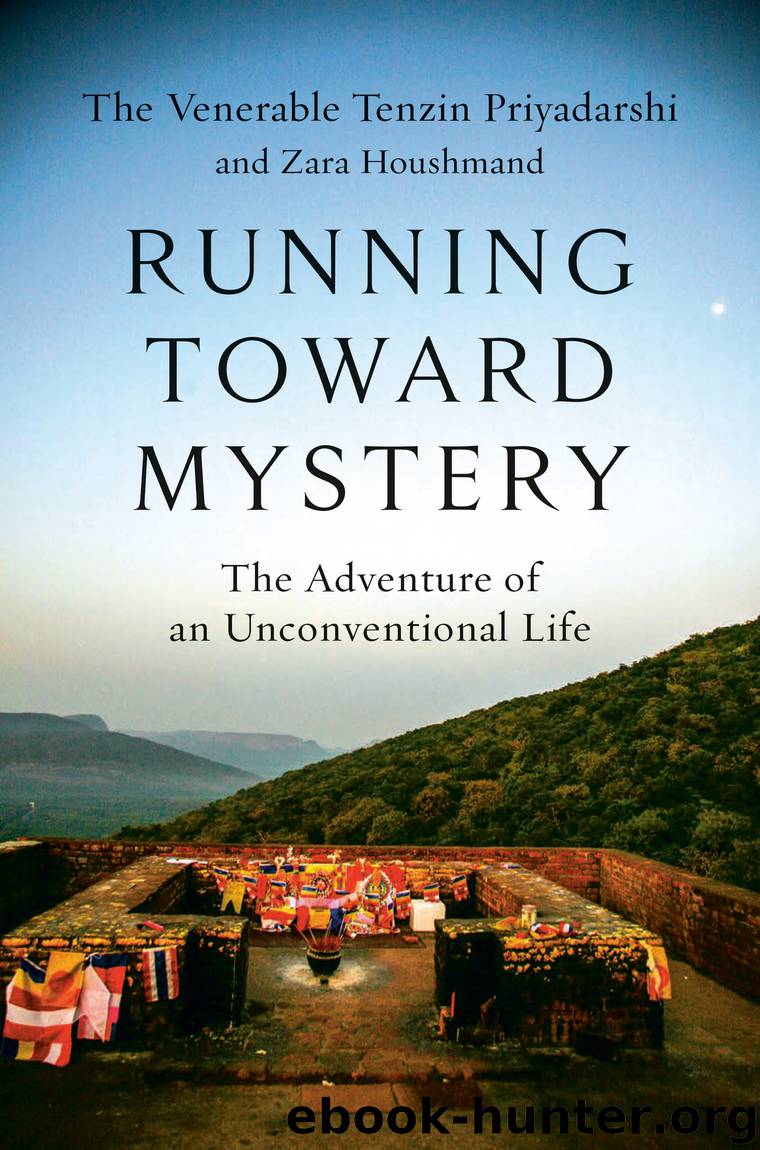Running Toward Mystery by Tenzin Priyadarshi & Zara Houshmand

Author:Tenzin Priyadarshi & Zara Houshmand [Priyadarshi, Tenzin & Houshmand, Zara]
Language: eng
Format: epub
Publisher: Random House Publishing Group
Published: 2020-04-07T00:00:00+00:00
* * *
•
While I was staying with Sasaki at the temple in Sarnath, my father came to visit. He said he had business in Varanasi but clearly he was making an effort to reach out to me. Sasaki insisted that he stay with us and fussed over fixing up a room for him. He seemed as excited in anticipation of the visit as I was apprehensive.
In the end it went smoothly, because both elders found a certain common ground. My father discovered that Sasaki had a wife. She was a nun who lived in Japan and looked after their home temple. This was not at all unusual in Japan, however unthinkable in the Buddhism of other traditions. During the Meiji Restoration in the nineteenth century, celibate monks without possessions or worldly obligations were seen as a threat to the state, much as the samurai were. You can’t control someone who has nothing to lose. So monks were pressured to marry, temples became property that was passed on through inheritance, and monastic ordination evolved into a hereditary priesthood. Fujii Guruji’s return to a stricter vision of monastic discipline that included celibacy was exceptional in the world he was born into.
When my father discovered that monks in Sasaki’s school could marry, a light bulb switched on: Here was a win-win solution to our intractable conflict. Obviously, I should be ordained as a Nichiren Shu monk, just like Sasaki, who thought it was a great idea. To me it seemed pointless and irresponsible. You couldn’t very well support a family and live in the world without ignoring a huge portion of how the Buddha had taught that a monk was supposed to live. You would either be a monk in name only, or a poor excuse for a husband. Neither fish nor fowl. My father clung to the idea until his dying day, but Sasaki conceded the common sense of my position: “So the monk now lives in India and the wife lives in Japan. What’s the point?”
“It’s true, there is no point!” he laughed.
It was this open-minded, nonjudgmental embrace of circumstance that made me feel bold enough to ask Sasaki for guidance on a related question that had gnawed at me for a long time. It was the issue of women. Not the ordinary question of women as most young men might define it, nor even the annoyance of my parents’ obsession with marriage and procreation, but the delicate issue of women and vows, and the seemingly contradictory messages built into the tradition. The prescriptions of the Vinaya are very specific about avoiding contact with women, avoiding even the appearance of impropriety. If I lived in a monastery, no doubt the logistical challenges would be moot, but it seemed impossible to negotiate the physical space of the modern world, the classrooms and dormitories and elevators and crowded buses, without breaking the rules.
At Le Moyne, I lived at Father Daniel Berrigan’s International House, which at that time shared the building with a Latino frat house.
Download
This site does not store any files on its server. We only index and link to content provided by other sites. Please contact the content providers to delete copyright contents if any and email us, we'll remove relevant links or contents immediately.
Becoming Supernatural by Dr. Joe Dispenza(7102)
Tools of Titans by Timothy Ferriss(6944)
The Witchcraft of Salem Village by Shirley Jackson(6582)
Inner Engineering: A Yogi's Guide to Joy by Sadhguru(5893)
The Four Agreements by Don Miguel Ruiz(5510)
The Power of Now: A Guide to Spiritual Enlightenment by Eckhart Tolle(4751)
The Wisdom of Sundays by Oprah Winfrey(4625)
Room 212 by Kate Stewart(4102)
Fear by Osho(4084)
Pale Blue Dot by Carl Sagan(4001)
The David Icke Guide to the Global Conspiracy (and how to end it) by David Icke(3881)
Rising Strong by Brene Brown(3779)
Animal Frequency by Melissa Alvarez(3752)
How to Change Your Mind by Michael Pollan(3673)
Sigil Witchery by Laura Tempest Zakroff(3651)
Real Magic by Dean Radin PhD(3567)
Secrets of Antigravity Propulsion: Tesla, UFOs, and Classified Aerospace Technology by Ph.D. Paul A. Laviolette(3438)
The Art of Happiness by The Dalai Lama(3382)
Man and His Symbols by Carl Gustav Jung(3314)
